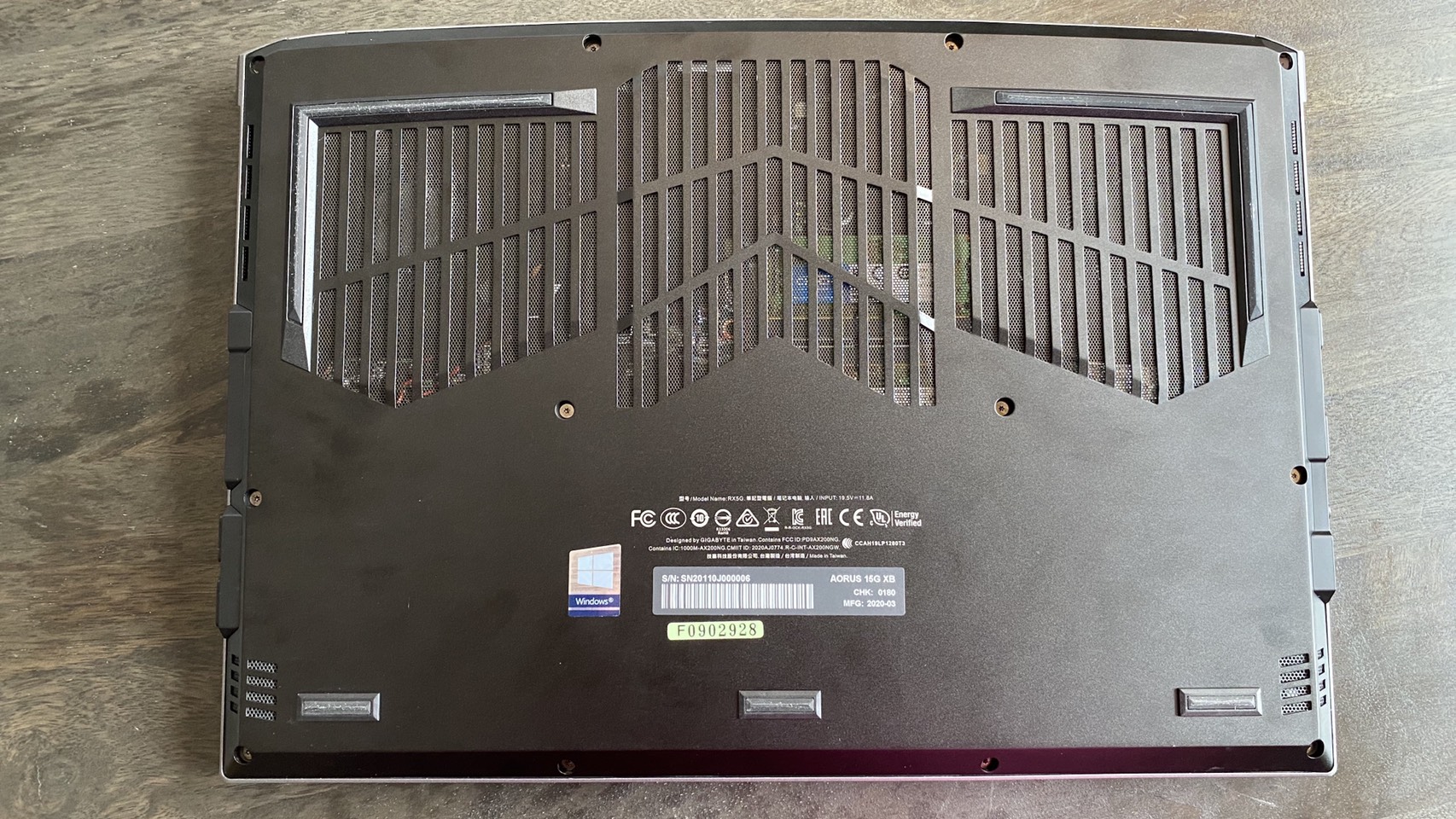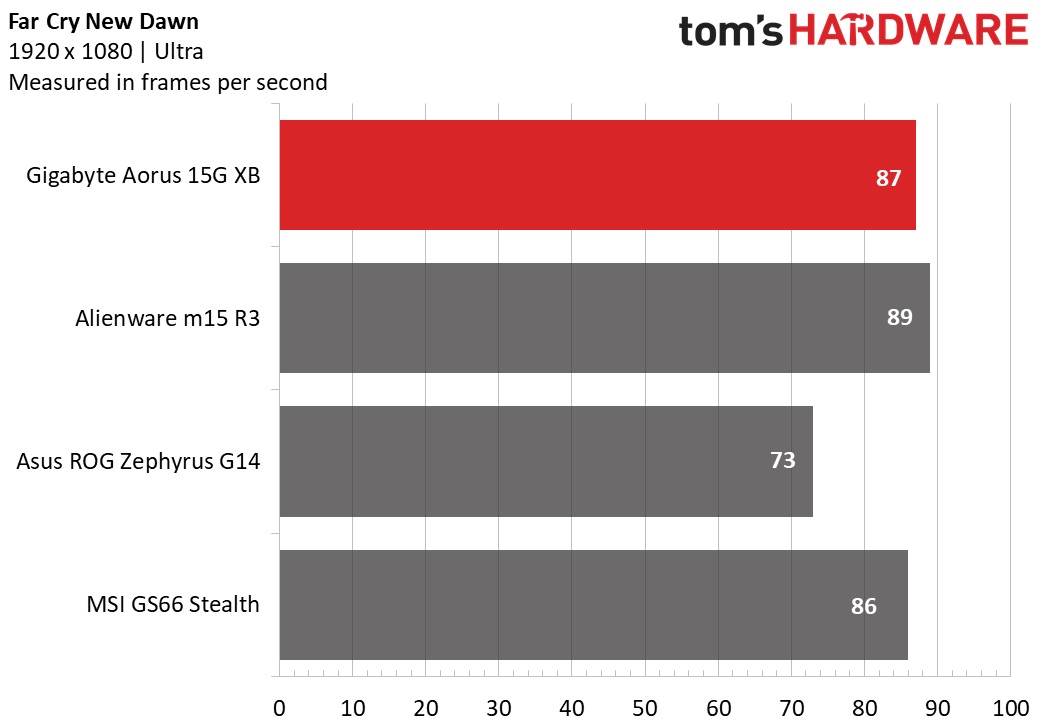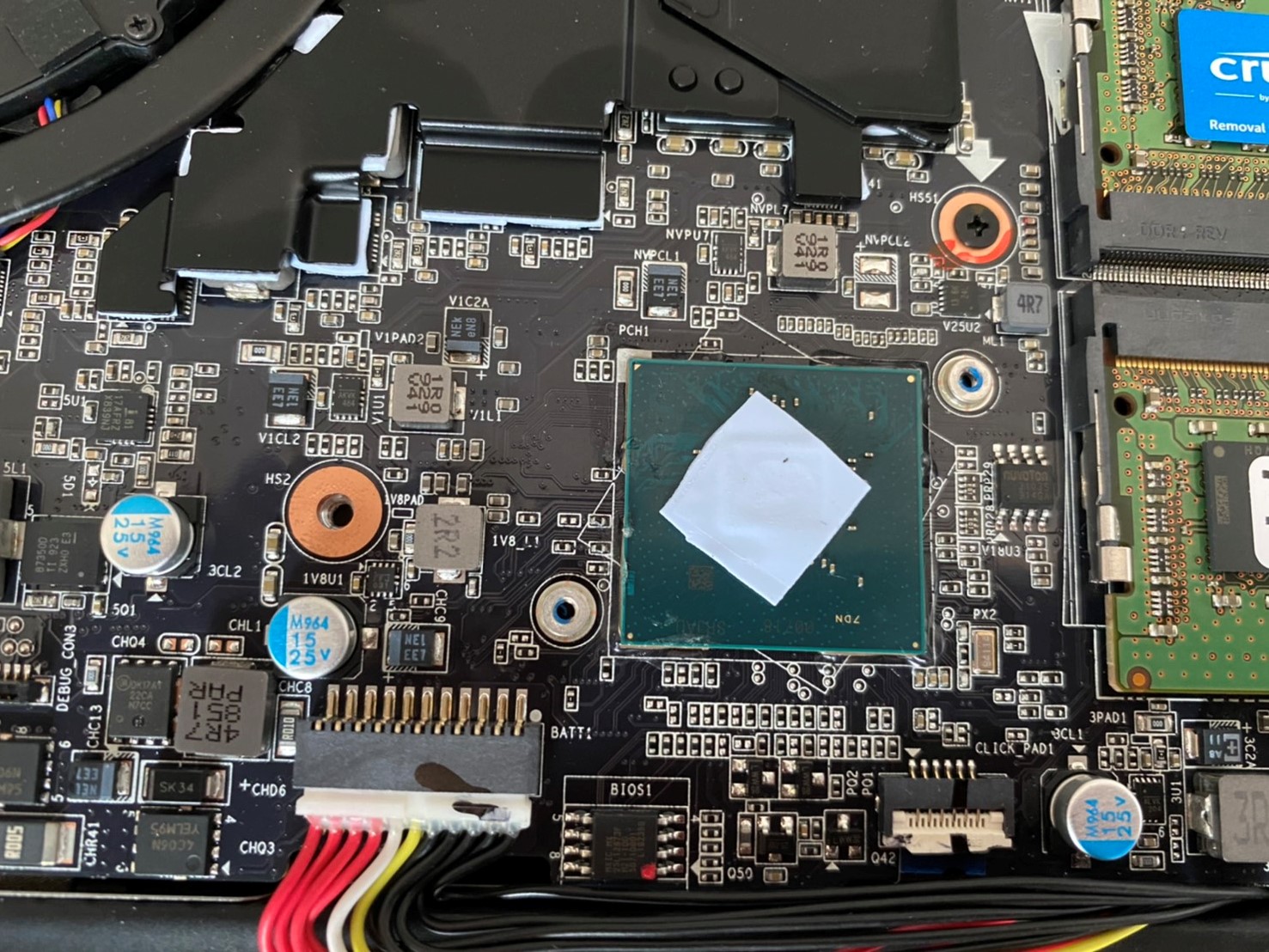Tom's Hardware Verdict
The Aorus 15G XB is the thinnest laptop with a full physical mechanical keyboard we've reviewed yet, making its powerful performance all the more impressive.
Pros
- +
Mechanical keyboard
- +
240 Hz display
- +
Strong productivity performance
Cons
- -
Poor webcam placement
- -
Dim screen with poor color reproduction
Why you can trust Tom's Hardware
The Aorus 15G XB is a respectably powerful machine for its price point ($1,799 to start, $2,295 as tested), with one unique advantage: a full mechanical keyboard. This lends it some extra heft and bulk compared to similarly-specced rivals, but that might be worth it for some given the keyboard’s luxurious 1.6mm actuation point. Its 240 Hz display, while not uncommon in high-end gaming, also lets it support high frame rates, though it can come across dim and washed out at times. Still, its strong input methods and fast display make this 10th Gen Intel Core i7-10875H powered laptop attractive to gamers who want to rely on what’s built into it rather than accessories.
Aorus 15G XB Specifications
| CPU | Intel Core i7-10875H |
|---|---|
| Graphics | Nvidia RTX 2070 Super Max-Q (8GB GDDR6) |
| RAM | 16GB DDR4-2666 |
| SSD | 512GB M.2 PCIe 3.0 SSD |
| Display | 1920 x 1080, 240Hz, LCD |
| Networking | 802.11 a/b/g Wi-Fi, Bluetooth 5.0 |
| Ports | 3x USB 3.2 Gen 1 Type-A, 1x Thunderbolt 3, 1x HDMI 2.0, 1x DisplayPort, 1x Combo Headphone/Mic Jack |
| Camera | 720p |
| Battery | 94 WHr |
| Power Adapter | 230W |
| Operating System | Windows 10 Pro |
| Size | 14 x 9.8 x 1 inches |
| Weight | 4.9 pounds |
| Price (as Configured) | $2,295.45 |
Design of Aorus 15G XB




At 14 x 9.8 x 1 inches and including a full physical mechanical keyboard, the Gigabyte Aorus 15G XB is a chunky machine. But thanks to some slick design decisions, it makes use of that extra space well. While it clearly comes across as a gaming machine, it shows restraint on flash, and for its efforts, looks plenty mature.
The whole machine, for instance, is coated with a matte black silver finish that resists fingerprints and looks premium, while branding is restricted to one light-up logo on the lid and a single “Aorus” under the screen. Curved edges and simple fan placement keep everything looking symmetrical, smooth and tucked away, but the webcam being placed under the screen gives me pause, even if it allows for thin bezels around the display.
The Aorus’ dimensions do make it bulkier than similarly specced competitors, though. The Asus ROG Zephyrus G14 is a much smaller 12.8 x 8.7 x 0.7 inches, for instance (though it has a smaller 14-inch display), while the MSI GS66 Stealth is still thinner than the Aorus at 14.2 x 9.7 x 0.7 inches. The Alienware m15 R3’s 14.2 x 9.8 x 0.8 measurements do outshine the Aorus length and width, but it is still thinner.
This Aorus’ chunk extends to weight, as the laptop is also heavier than its rivals. Weighing in at 4.9 pounds, it is noticeably heavier than the 3.5 pound Zephyrus, while still maintaining significant heft over the 4.6 pound Stealth and the 4.7 pound m15 R3.
However, considering that the Aorus includes a full physical switch mechanical keyboard while these competitors do not, it’s still impressively compact.
The Aorus’ left side includes a single USB 3.2 Gen 1 Type-A port, an RJ-45 ethernet connector, a combination headphone and microphone jack, and HDMI 2.0 port and a DisplayPort connector. The right side, then, holds two USB 3.2 Gen 1 Type-A ports, a Thunderbolt 3 port, a full-size SD card reader and the DC input. There is no lock slot on the Aorus.
Aorus 15G XB Gaming Performance
The Aorus is powerful enough in gaming to keep up with and sometimes eclipse its rivals, meaning that what will really make or break this laptop is its display and its input.
The Aorus 15G XB comes equipped with an Nvidia RTX 2070 Super Max-Q, an Intel Core i7-10875H, 16GB of DDR4-2666 RAM and a 512GB M.2 PCIe 3.0 SSD. This puts it in a comfortable middle ground compared to competitors, with stronger parts on paper than the Asus ROG Zephyrus G14 (Ryzen 9 4900HS, RTX 2060, 16GB RAM) but weaker parts on paper than the MSI GS66 Stealth (i7-10750H, RTX 2080 Super Max-Q, 32GB RAM). Its closest recent competitor is likely the Alienware m15 R3 (i7-10750H, RTX 2070 Super, 16GB of RAM), though its CPU outshines its other Intel-based contemporaries.
In personal use, I played Control at FHD high graphics presets for about a half hour on the Aorus, varying between turning ray tracing on or off. Frame rate here was a mostly comfortable 60 fps with only occasional dips to 58 fps, as well as infrequent jumps to 65 fps. This made for a fluid experience, though the game didn’t fare as well with ray tracing on. At high presets, ray tracing reduced my typical fps to around 28, with valleys of 25 and peaks of 35 depending on how much action was on screen.




The Aorus slightly lagged behind on Grand Theft Auto V’s built-in benchmark (1920 x 1080, very high), where its average of 76 fps fell four frames behind the m15 R3’s 80 fps and 6 frames behind the Stealth’s 82 fps. The laptop with the weakest GPU, the Zephyrus, scored highest with an average fps of 115, but this game happens to be particularly CPU-bound.
Get Tom's Hardware's best news and in-depth reviews, straight to your inbox.
However, the tide turned in the Aorus’ favor in the Shadow of the Tomb Raider benchmark (1920 x 1080, highest), where it outperformed all of the competitors we tested, even if just narrowly. Here it scored an average 68 fps, which was slightly higher than the m15 R3’s 63 fps and the Stealth’s 66 fps. It most noticeably outperformed the Zephyrus, which earned an average of just 49 fps.
In Far Cry: New Dawn’s benchmark (1920 x 1080, ultra), the Aorus kept pace with the rest of the field. With an 87 fps average, it fit snugly between the Stealth’s 86 fps and the m15 R3’s 89 fps. The Zephyrus again performed the worst of the four, hitting an average frame rate of 73 fps.
We also ran the Aorus through Metro: Exodus’ 1080p RTX benchmark on a loop 15 times to simulate a half hour of intense gaming. It scored an average of 49.1 fps, with a CPU clock speed of 4.07 GHz and a GPU clock speed of 1.34 GHz. It also kept as cool as we could expect during such an intense test, with CPU temperatures averaging 79 degrees Celsius (174.2 degrees Fahrenheit) and GPU temperatures averaging 72 degrees Celsius (161.7 degrees Fahrenheit).
Aorus 15G XB Productivity Performance
On top of strong gaming specs, the Aorus also proved adept at productivity work in our testing.



In our Geekbench 5.0 benchmark, which measures general productivity performance, the Aorus was the second highest scorer among its competitors. At 7,194 points, it was well ahead of both the m15 R3’s 6,244 points and the Stealth’s 6,238 points. Only the Zephyrus outperformed it, earning 7,895 points.
The same pattern held true in our Handbrake benchmark, which tracks how long it takes a computer to transcode a video down from 4K to FHD. Completing the task in 7 minutes and 59 seconds, the Aorus came ahead of both the m15 R3’s 8:17 and the Stealth’s 9:25. The Zephyrus, meanwhile, finished the job in 6:59.
The only area where the Aorus struggled was in our file transfer test, which measures how fast a computer can move 4.97GB of files. The Aorus fell well short of its competitors here, with a file transfer speed of 658 MBps. That’s not nearly as fast as the m15 R3’s 1,210 MBps, the Zephyrus’ 1,272.3 MBps and the Stealth’s 1,696.4 MBps.
Aorus 15G XB Display
The Aorus 15G XB comes with a 15.6 inch FHD LCD display that supports frame rates up to 240 Hz, but lags behind on color and brightness.
I tested the screen by watching the trailer for The Rental in both high and low light environments, though the screen only performed marginally better in low light. The most noticeable issue was the dim picture, which appeared far less bright than when watching the trailer on my iPhone and desktop monitor. Blacks also lacked depth, making the film’s numerous nighttime scenes difficult to follow, while brighter scenes suffered from a lack of vivid color.
Viewing angles were also poor, as I noticed heavy reflection on the screen when trying to look at it from more than 30 degrees away from its center. This applied both when viewing from horizontal and vertical angles, as well as in high and low light.
Our testing backed up my findings, as the Aorus captured significantly less of the DCI-P3 color spectrum than its competitors. It registered a 61% DCI-P3 rating, coming in more than a dozen percentage points below its closest rival, the m15 R3, which scored a 79% DCI-P3 rating. The Stealth was even higher, earning a 79% DCI-P3 rating, while the Zephyrus covered an entire 82.9% of the DCI-P3 spectrum.
Brightness testing showed similar results, as the Aorus hit 243 nits of average brightness in our tests, while the m15 R3 hit 285 nits and the Stealth rose to 321 nits. The Zephyrus shined here, with 323 nits of average brightness.
Aorus 15G XB Keyboard and Touchpad
The Aorus advertises itself as the world’s “thinnest and lightest” laptop with a mechanical keyboard, though we’ve previously reviewed smaller laptops with optical mechanical keyboards. For laptops with physical mechanical keyboard switches, however, this is definitely among the thinnest we’ve seen.
The Aorus' keyboard uses exclusive Omron switches with a 1.6mm actuation point and a Blue switch style 2.55mm key height. In my practice, this puts it almost on par with my Razer Huntsman desktop keyboard for comfort and speed both while gaming and typing. My 10fastfingers score, for instance, was only one point off my typical 75 words-per-minute. This keyboard offers just enough resistance to give clear, clicky feedback once a button has been pressed, without requiring so much pressure that it slows down typing. Switches also emit a pleasant, clicking noise on actuation that isn’t too loud, while the no-nonsense Arial-like font and full per-key RGB keep the whole keyboard easy on the eyes.
The glass precision touchpad is among the smoothest I’ve used, offering just the right amount of friction, but there is a catch. The Aorus’ fingerprint reader sits in the touchpad’s upper left corner, and acts as a dead zone when swiping. We would prefer this be elsewhere on the deck for more active touchpad real estate.
Aorus 15G XB Audio
The Aorus 15G XB comes with combination bottom and side-firing speakers that are decent on bass, but tinny elsewhere and quiet overall.
Listening to DJ Khaled’s Popstar, I could keep track of the rap track fine, but that was about it. The piano-style synth that makes up about half of the beat sounded tinny and distorted, and while the bass had a greater presence than on other similar laptops, its regular clapping noise came across weak and tinny as well. Volume was somewhat of an issue. While I could fill my office with louder-than-average music on higher volume settings, I never once reached anything I would consider booming, and the sound quickly dissipated when leaving the room.
Aorus 15G XB Upgradeability






The Aorus 15G XB is simple to open and upgrade, provided you have a Torx screwdriver. Just unscrew the 12 Torx head screws on the laptop’s bottom case and lift it up. This will give you access to the memory, the SSD, the Wi-Fi card and a second SSD slot.
Aorus 15G XB Battery Life
The Aorus touted an average battery life for a gaming laptop in our benchmark, which continuously streams video and runs OpenGL tests at 150 nits of brightness. Here, it maintained a steady 6 hours and 16 minutes of performance before running out of par, which puts it just 20 minutes below the MSI GS66 Stealth’s 6:36 battery life on the same test. While it didn’t come close to the ROG Zephyrus G14’s standout 11:32 battery life, it also didn’t dip to the 2:39 battery life levels of the Alienware m15 R3 (with a 300 Hz display that can only use discrete graphics).
Aorus 15G XB Heat
The Aorus was impressively cool for an RTX-powered gaming laptop, and its vent placement means that both its touchpoints and the area immediately around the computer stay cool during use.
After 15 minutes of streaming video on YouTube, the touchpad was the coolest of the Aorus’ touchpoints. It registered 77.5 degrees Fahrenheit (25.3 degrees Celsius), which was just below the center of the keyboard between the G&H keys. This area measured 78 degrees Fahrenheit (25.5 degrees Celsius). The hottest area on the Aorus was its underside, specifically towards the center, which crept up to 88.5 degrees Fahrenheit (31.4 degrees Celsius).
Aorus 15G XB Webcam
The Aorus’ webcam has decent color quality in both high and low light, as well as lacks grain or pixelation, and it captures texture well. It also has a webcam cover, which is great for privacy. Too bad most of these features feel relatively pointless due to the webcam’s poor, below-the-screen placement.
To save space on the bezel, Gigabyte placed the webcam on the Aorus just below its screen, which leads to two major problems: an unflattering angle, and being unable to make eye contact when looking at the screen. If you’re using this laptop to attend video calls or take selfies, both of these are fairly damning.
That's why we suggest going external and picking up the Logitech c920 or one of the market's other best webcams.
Aorus 15G XB Software and Warranty
The Aorus 15G XB comes mostly free of bloat, aside from standard Windows pack-ins like Candy Crush Friends. One social media app managed to sneak in- LinkedIn- with music program Spotify rounding out the non-utility inclusions.
As for those utility programs, there aren’t a ton.. Nahimic is here, which lets you set up post-processing effects for both your microphone and audio output, including software-powered pseudo-surround sound. Finally, there’s both Gigabyte Smart Backup, which lets you create rescue drives without needing to use Windows’ recovery options, and the Killer Control Center, which lets you read and optimize your Wi-Fi network’s app usage.
Gigabyte’s RGB Fusion 2.0 software, which you use to adjust the keyboard’s lighting, is conspicuously absent. It is, however, available as a free download on Gigabyte's website.
Configurations
The Aorus 15G XB comes with an Intel Core i7-10875H processor, an Nvidia GeForce RTX 2070 Super Max-Q, 16GB of DDR4-2666 RAM and a 512TB M.2 PCIe 3.0 SSD. The screen is 15.6 inches, with a 240 Hz FHD LCD display. It currently costs at $2295.45.
There are other Aorus 15G models with similar specs, such as the Aorus 15G WB, which packs the same specs except for its Core i7-10750H processor and 144 Hz FHD display. This model recently had a price drop down to $1,799, making it the most affordable available. On the other side of the spectrum is the Aorus 15G YB, which keeps the same specs as our config, but swaps out the GPU for an RTX 2080 Super Max-Q. For that extra graphics power, you’d be paying $2,999.
Bottom Line
The Gigabyte Aorus 15G XB is an excellent laptop for gamers where input is a priority. With just a little bit of extra chunk, it manages to fit an almost desktop-caliber mechanical keyboard into its frame, while still keeping up with competition on performance. Unfortunately, the Aorus 15 XB suffers from poor audio fidelity as well as subpar display brightness and color coverage, but a high refresh rate keeps the screen from being irrelevant when placed alongside rivals. The whole machine has enough class and productivity performance to moonlight as a work device.
If you want a similar, albeit smaller machine than the Aorus, the MSI GS66 Stealth comes close, though it sacrifices the mechanical keyboard and tends to run hot. It does pack a slightly better GPU, though its productivity performance left us wanting. The $2,699 price tag on the model we tested is about dead even with the Aorus, however.
The Alienware m15 R3, meanwhile, packs a full-sized RTX 2070 Super that let it slightly outperform the Aorus in some games. Still, it also lacks the mechanical keyboard and productivity power of the Aorus, and despite being thinner, is actually longer and wider. The model we reviewed is, however, less expensive at $2,165.79.
The Asus ROG Zephyrus G14 is a great budget competitor for the Aorus, coming in at $1,449 for an AMD Ryzen 4900HS, an RTX 2060 ROG Boost and no mechanical keyboard. While significantly behind the other computers we tested in most games, it is also the thinnest and the lightest and has a much longer battery life.
If a good keyboard is important to you, however, the Aorus 15G XB is a great way to snag a mechanical keyboard on a powerful laptop without paying extra for the privilege.
Michelle Ehrhardt is an editor at Tom's Hardware. She's been following tech since her family got a Gateway running Windows 95, and is now on her third custom-built system. Her work has been published in publications like Paste, The Atlantic, and Kill Screen, just to name a few. She also holds a master's degree in game design from NYU.




